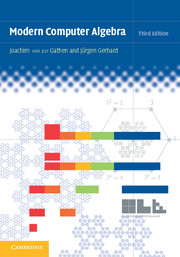Book contents
- Frontmatter
- Contents
- Introduction
- 1 Cyclohexane, cryptography, codes, and computer algebra
- I Euclid
- II Newton
- 8 Fast multiplication
- 9 Newton iteration
- 10 Fast polynomial evaluation and interpolation
- 11 Fast Euclidean Algorithm
- 12 Fast linear algebra
- 13 Fourier Transform and image compression
- III Gauß
- IV Fermat
- V Hilbert
- Appendix
- Sources of illustrations
- Sources of quotations
- List of algorithms
- List of figures and tables
- References
- List of notation
- Index
- The Holy Qur'ān (732)
9 - Newton iteration
from II - Newton
Published online by Cambridge University Press: 05 May 2013
- Frontmatter
- Contents
- Introduction
- 1 Cyclohexane, cryptography, codes, and computer algebra
- I Euclid
- II Newton
- 8 Fast multiplication
- 9 Newton iteration
- 10 Fast polynomial evaluation and interpolation
- 11 Fast Euclidean Algorithm
- 12 Fast linear algebra
- 13 Fourier Transform and image compression
- III Gauß
- IV Fermat
- V Hilbert
- Appendix
- Sources of illustrations
- Sources of quotations
- List of algorithms
- List of figures and tables
- References
- List of notation
- Index
- The Holy Qur'ān (732)
Summary
We mentioned on pages 218–219 Newton's method for approximating roots of polynomials. It has become a staple of numerical computation, and seen many generalizations and improvements over the years. But what does this decidedly continuous, approximative method, computing values that are closer and closer to some real root, have to do with the discrete, exact calculations prevalent in computer algebra? There is a somewhat counter-intuitive notion of closeness for integers (and polynomials), corresponding to divisibility by higher and higher powers of a fixed prime. Newton iteration works just beautifully in this purely algebraic setting.
We start by using it to find a custom-Taylored division algorithm that is about as fast as multiplication, and then describe its use for finding roots of polynomials. Finally, we describe a common framework—valuations—into which both the analytical method over the real numbers and our symbolic version fit. In Chapter 15, we will apply Newton's method to the factorization of polynomials; it is then called Hensel lifting.
Information
- Type
- Chapter
- Information
- Modern Computer Algebra , pp. 257 - 294Publisher: Cambridge University PressPrint publication year: 2013
Accessibility standard: Unknown
Why this information is here
This section outlines the accessibility features of this content - including support for screen readers, full keyboard navigation and high-contrast display options. This may not be relevant for you.Accessibility Information
- 2
- Cited by
